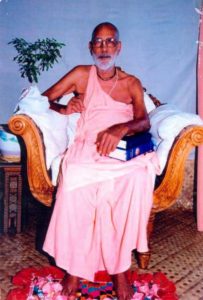
Srila Bhaktivedanta Narayana Goswami Maharaja
Excerpts from Srila Bhaktivedanta Narayana Maharaja’s “Necar Sprinkles on Australia”
We shall continue our reading from Caitanya-caritamrta, Third Chapter, which explains who Sri Caitanya Mahaprabhu is, and how and why He came to this world.
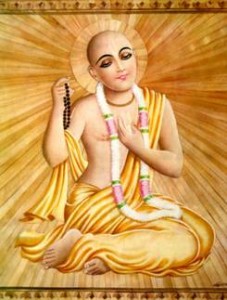
Lord Chaitanya Mahaprabhu
Srila Krsnadasa Kaviraja tells us that Sri Caitanya Mahaprabhu, Sri Sacinandana Gaurahari, is Krsna Himself, Svayam Krsna. He is not only Bhagavan, but Svayam Bhagavan 1, Vrajendranandana Krsna. This Krsna is eternally situated with all His attributes, and with His power, which is personified in the form of Srimati Radhika. Even if the sun could be separated from its heat and light, Radha and Krsna can never be separated.
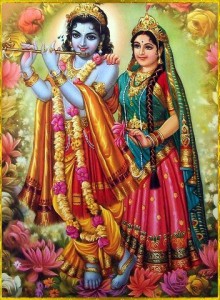
Sri Sri Radha And Krishna
Krsna played in Vrndavana for ten years.
He took birth in Mahavana Gokula and played there for His first few years.
Then both His family and Sri Radha’s family moved to Vrndavana, where They enjoyed unlimited pastimes. Later both families moved near Radha-kunda, where Nanda Baba stayed at Calgrama. They then moved to Kamyavana, then Kelanvana, and finally to Nandagaon Gokula and Varsana respectively. In each dwelling place They made a new village, and so Their villages were always side-by-side. Radha and Krsna met at these places and eternally performed Their topmost pastime of rasa-lila, as well as other pastimes there.

Vrindavan dham
When Krsna comes to this world, the whole of Vraja comes with Him: His associates, the Yamuna river, Govardhana hill, Bhandiravana forest, and the entire 84 krosas of Vrndavana. He comes once in a day of Brahma, in order to taste the five rasas of His pastimes-santa, dasya, sakhya, vatsalya, and madhurya. Although he enjoys these rasas, He still has three unfulfilled desires; and to fulfill these is the essential reason for His appearance as Caitanya Mahaprabhu. Also, because He is an ocean of causeless mercy and an ocean of rasa, He wanted to sprinkle drops of special mercy on the jivas, so that they would come to Him and serve Him forever.
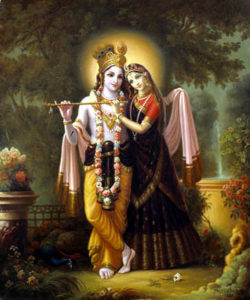
Sri Sri Radha and Krishna
Devotee reads: In this chapter of the epic Caitanya-caritamrta, Krsnadasa Kaviraja Gosvami has stressed that Lord Caitanya appeared for three principal purposes of His own. The first purpose was to relish the position of Srimati Radharani, who is the prime reciprocator of transcendental love of Sri Krsna. Lord Krsna is the reservoir of transcendental loving transactions with Srimati Radharani. The subject of those loving transactions is the Lord Himself, and Radharani is the object. Thus the subject, the Lord, wanted to relish the loving mellow in the position of the object, Radharani.
The second reason for His appearance was to understand the transcendental mellow of Himself. Lord Krsna is all sweetness.
Radharani’s attraction for Krsna is sublime, and to experience that attraction and understand the transcendental sweetness of Himself, He accepted the mentality of Radharani.
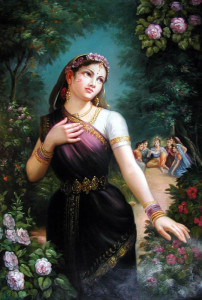
The third reason that Lord Caitanya appeared was to enjoy the bliss tasted by Radharani. The Lord thought that undoubtedly Radharani enjoyed His company and He enjoyed the company of Radharani, but the exchange of transcendental mellow between the spiritual couple was more pleasing to Srimati Radharani than to Sri Krsna. Radharani felt more transcendental pleasure in the company of Krsna than He could understand without taking Her position, but for Sri Krsna to enjoy in the position of Srimati Radharani was impossible because that position was completely foreign to Him. Krsna is the transcendental male, and Radharani is the transcendental female. Therefore, to know the transcendental pleasure of loving Krsna, Lord Krsna Himself appeared as Lord Caitanya, accepting the emotions and bodily luster of Srimati Radharani.
Lord Caitanya appeared to fulfill these confidential desires and also to preach the special significance of chanting Hare Krsna, Hare Krsna, Krsna Krsna, Hare Hare / Hare Rama, Hare Rama, Rama Rama, Hare Hare, and to answer the call of Advaita Prabhu. These were secondary reasons.
Sri Svarupa Damodara Gosvami was the principal figure among Lord Caitanya’s confidential devotees. The records of his diary have revealed these confidential purposes of the Lord. These revelations have been confirmed by the statements of Srila Rupa Gosvami in his various prayers and poems.
This chapter also specifically describes the difference between lust and love. The transactions of Krsna and Radha are completely different from material lust.
Therefore the author has very clearly distinguished between them. [C-c, Adi-lila, Ch. 4 introduction]
Srila Maharaja: While Krsna was thinking how to fulfill His desires, the time came in Kali-yuga to preach the yuga-dharma, the religion of the age. At the same time, Advaita Acarya came to prepare a platform for the descent of Krsna and His associates.
Advaita Acarya wanted to give krsna-prema, but He could not-because this was not the function of Mahavisnu.
This was not even possible for Rama, Nrsimha, Kalki, Vamana, or Parasurama.
All of these avataras could establish the yuga-dharma, but they could not give to plants, animals, creepers, or anyone what Svayam Bhagavan, Vrajendranandana Krsna could give-prema-bhakti.
Baladeva Prabhu can give this special prema, but does not. He reserves it for Krsna to give and He, Himself, simply assists. Similarly in the pastimes of Sri Caitanya Mahaprabhu, Sri Nityananda Prabhu can also distribute that special krsna-prema, madhurya-prema but He never does. He leaves it for Sri Caitanya Mahaprabhu and His associates like Sri Svarupa Damodara, Raya Ramananda, Srila Rupa Gosvami, Srila Sanatana Gosvami and others like them. Sri Nityananda Himself distributed general prema.
So there are four reasons for Sri Caitanya Mahaprabhu’s appearance-two external and two internal. The external reasons were firstly to establish yuga-dharma, and secondly to satisfy Advaita Acarya who, offering tulasi leaves, called for Krsna to descend.
By his love, Advaita Acarya induced Krsna to come to this world. If any devotee takes very soft leaves of tulasi, with a manjari in the middle, and offers it to Krsna, while weeping and praying to Him, Krsna will not be able to refuse that devotee. He will have to leave Goloka Vrndavana, and at once come to him. To inspire Krsna to hear us, we should also worship tulasi daily, as Advaita Acarya has done. By this method we can certainly please Krsna, even if we are unable to please Him in other ways. By this method Sri Caitanya Mahaprabhu and Sri Nityananda Prabhu, and all Their associates will enter our hearts.
Actually, Caitanya Mahaprabhu, Sri Sacinandana Gaurahari is Krsna Himself, and Sri Nityananda is Baladeva Prabhu.
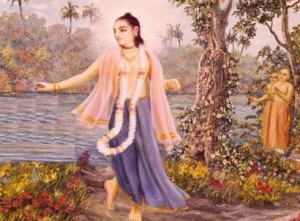
Lord Nityananda
Through sankirtana, the yuga-dharma, Sri Caitanya Mahaprabhu bestowed His prema to all types of living entities. Even Krsna could not have induced the forest inhabitants to chant and dance as Sri Caitanya Mahaprabhu did. Serpents, elephants, tigers, she-goats-everyone became inspired by Sri Caitanya Mahaprabhu. He sang, “Krsna, Krsna, Krsna, Krsna, Krsna, Krsna, Krsna he.
Krsna, Krsna, Krsna, Krsna, Krsna, Krsna, raksa mam. Krsna, Krsna, Krsna, Krsna, Krsna, Krsna, pahi mam. Rama Raghava, Rama Raghava, Rama Raghava, raksa mam.
Krsna Kesava, Krsna Kesava, Krsna Kesava, pahi mam.” At this time Sri Caitanya Mahaprabhu was not in His external senses. He was weeping and sometimes rolling on the ground. Overwhelmed, all the animals, creepers, and trees began to chant along with Him.
So Sri Caitanya Mahaprabhu distributed this rare prema, which He did not even give to Brahma, Sankara, Uddhava, and Narada, to all who came to Him. He made serpents into Vraja serpents, deers into Vraja deers, and cows into Vraja cows.
After receiving Sri Caitanya Mahaprabhu’s mercy they all developed intense affection for Krsna.
When Krsna came to this world He was also merciful, but He gave krsna-prema according to the quality of the devotee’s surrender and devotional practice-not less, not more, but in the same quantity, like a scale.
ye yatha mam prapadyante tams tathaiva bhajamy aham mama vartmanuvartante manusyah partha sarvasah
As all surrender unto Me, I reward them accordingly. Everyone follows My path in all respects, O son of Prtha. [B-g. 4.11]
An analogy may be given about a pot. This pot represents our qualification for krsna-prema. When Krsna was present He never gave a pot to anyone. He said, “O, bring your pot. According to the type and size of your pot I will give you that much prema.”
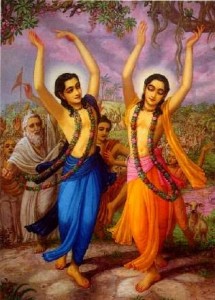
Lord Nityananda (left) and Lord Caitanya Mahaprabhu
Without your qualification, Krsna will not give you prema. If you have committed many offenses He will not give prema. But Sri Caitanya Mahaprabhu is giving the pot-and the prema. He and Sri Nityananda Prabhu are so merciful. They have no scale at all. Because Sri Caitanya Mahaprabhu, Sacinandana Gaurahari is the son of Sacidevi, He is so merciful that whoever comes to Him receives His mercy.
Without a scale He says, “O, come on, come on. Do you have a pot?” “No, I have no pot. No qualification.” “Oh, alright then. I will give you the pot and also this nectar, krsna-prema.”
Sri Caitanya Mahaprabhu gave prema to so many, but this is only a secondary reason for His appearance. The primary cause for Krsna’s descent as Sri Caitanya Mahaprabhu was to taste the three moods of Srimati Radhika, which only She could taste. He therefore borrowed Her internal mood and beauty, and became tadatma with Her. Tadatma means oneness. For example, when iron is placed in fire it can burn.
Iron does not burn; only fire has this power. But, when placed in fire, the iron becomes tadatma with it, and can therefore also burn. Similarly, Krsna became tadatma with Radhika, and forgot that He is Krsna.
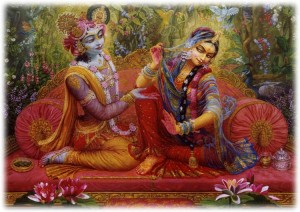
Sri Sri Radha And Krishna.
When Sri Caitanya Mahaprabhu met Raya Ramananda at Godavari, He learned rasa-tattva from him. Raya Ramananda is Visakha, and Sri Caitanya Mahaprabhu is Krsna. Krsna, in the form of Caitanya, made Srimati Visakha-devi His guru, to help Him develop the mood and beauty of Radha. After that, Krsna, as Sri Caitanya Mahaprabhu, became mahabhava-rasaraja-svarupa. Without accepting Visakha as His guru, this would not have been possible. So, after meeting with Raya Ramananda, Sri Caitanya Mahaprabhu tasted these three moods in the Gambhira at Jagannatha Puri. He is therefore very grateful to Visakha and also to Lalita. Without their help Krsna cannot taste Radhika’s three moods.
Because Sri Caitanya Mahaprabhu is Krsna, He can distribute vraja-prema, especially parakiya-bhava (love between a paramour and the beloved). This is called unnata-ujjvala-rasa. Unnata means highest, and ujjvala means brilliantly shining. Rasa means the mellow of a specific relationship with Krsna.
The brilliance of unnata-ujjvala-rasa is unparalleled. All of our acaryas in the Gaudiya sampradaya have come to this world to teach this. They did not come to taste what Sri Caitanya Mahaprabhu came to taste, but to distribute this same rasa which Mahaprabhu came to distribute.
The distribution of unnata-ujjvala-rasa is the main reason, but not the foremost supreme reason for Sri Caitanya Mahaprabhu’s advent. It is the second internal reason. The first was to taste Radha’s mood, and the second internal reason was to distribute the service to that mood. He wanted to distribute that prema which is rare even for Brahma, Sankara and Narada upon the jivas. This is Sri Caitanya Mahaprabhu’s mission and can only be done by the power of Krsna in the form of Caitanya Mahaprabhu.
Similarly, all our acaryas, like Srila Rupa Gosvami, Srila Sanatana Gosvami, Srila Jiva Gosvami, Srila Raghunatha dasa Gosvami, Srila Krsnadasa Kaviraja, Srila Visvanatha Cakravarti Thakura, Srila Syamananda Prabhu, Srila Narottama dasa Thakura, Srila Srinivasa Acarya, Srila Bhaktivinoda Thakura, Srila Baladeva Vidyabhusana, Srila Prabhupada Bhaktisiddhanta Sarasvati Thakura, Srila Bhaktiprajnana Kesava Gosvami Maharaja, and Srila Bhaktivedanta Swami Maharaja-they have not come only to preach the glories of chanting the holy name. This can also be done by the associates of Mahavisnu. Try to understand this point. The expansions or manifestations of Mahavisnu, like Advaita Acarya, can preach and distribute the holy name, but they cannot preach vraja-prema through nama-prema-sankirtana. There is a vast difference between the nama-sankirtana of this Kali-yuga and that of other Kali-yugas. This is a specialty of Sri Caitanya Mahaprabhu, and His followers, His associates.
Incarnations of Mahavisnu, like Advaita Acarya and associates like Sanaka, Sanandana, Sanatana, Sanat Kumara, Visvaksena, and all the associates of Visnu, can perform and establish nama-sankirtana, and yuga-dharma, but that nama-sankirtana will not give krsna-prema, vraja-prema. The nama-sankirtana of Sri Caitanya Mahaprabhu and His associates has a special power that can give this.
Unnata-ujjvala-rasa is the special mood of Srimati Radhika. It can be tasted by Krsna as Sri Caitanya Mahaprabhu, but cannot be distributed.
What then did Sri Caitanya Mahaprabhu give? He did give unnata-ujjvala-rasa, but unnata-ujjvala-rasa is of two kinds: kamatmika (which He tasted) and tad-tad-bhava-icchatmika (which He distributed). Kamatmika is the mood of Srimati Radhika, Lalita, Visakha, and the other eight principle gopis, and all other gopis like them.
Srimati Radhika has five kinds of sakhis (gopi friends): sakhi, nitya-sakhi, prana-sakhi, priya-sakhi and priya-narma-sakhis.
1. Sakhis–Danistha is an example.
These sakhis love and serve Srimati Radhika and Krsna, but they are slightly more inclined towards Krsna.
2. Nitya–sakhis and 3. prana–sakhis are the only two kinds of sakhis who are in the category of tad-tad-bhava-icchatmika.
It is their service that Sri Caitanya Mahaprabhu ultimately came to give the jivas. These sakhis serve both Radha and Krsna, with a tendency to favor Srimati Radhika and render service to Her. They obey only Her. The prana-sakhis, like Rupa manjari and Rati manjari, being even more intimately connected with Her, are naturally the leaders of the nitya-sakhis.
4. Priya-sakhis and 5. priya-narma-sakhis–Lalita and Visakha are examples.
Among the sakhis the priya-sakhis and the priya-narma-sakhis are most dear, and they both serve yugala-kisora, the divine youthful couple, but with a slight tendency towards Srimati Radhika. Both these sakhis have so much power that they can sometimes chastise Radhika and at other times chastise Krsna.
The difference between the nitya and prana-sakhis, and the priya and priya-narma-sakhis is that the nitya-sakhis and prana-sakhis are called manjaris. They do not do anything for their own personal relationship with Krsna. They do everything for Srimati Radhika. They have no desire to taste anything for themselves. This bhava, which is called tad-tad-bhava-icchatmika, is also unnata-ujjvala-rasa. It is this type of unnata-ujjvala-rasa that Sri Caitanya Mahaprabhu came to distribute.
This is a very high topic and I am speaking it for only a very few, rare persons.
One may ask why I am speaking about it at all. In this sloka it is explained that to do sadhana we must first be clear about our objective. For example, if we want money we may have to serve the government, get a job, or do business. If you do not do business you might steal, and if you are not expert in stealing, you might get a group of dacoits and forcefully attack with swords like the asuras (demons). Krsna also forcefully attacked Bhismaka’s kingdom, where lakhs and lakhs of kings and their armies waited in full force to protect Rukmini from Krsna. But Krsna, like a lion entering a group of jackals took Rukmini on His chariot and rode to Dvaraka where He married her.
If someone’s goal is to accumulate money, and if, by begging, he doesn’t get it, he will get it by hook or by crook. Outside a sweet shop a dog will drool as he watches people eat rasagulla and rasam alai. He will not enter the shop, which the owner guards with a stick, but runs to lick from the leaf cups when they have been thrown away. And while he is licking the cups he will try to guard them from any other dog in the vicinity.
Similarly, in spiritual life our objective should first be fixed, and then we can decide how to achieve it. This practice is called sadhana and the goal is called sadhya. Without the sadhya one cannot determine his sadhana. This is why Krsnadasa Kaviraja presents the sadhya in the first sloka after the mangalacarana of Caitanya-caritamrta (Adi-lila: 1.4).
Is your objective to accept what Sri Caitanya Mahaprabhu came to give-that vraja-prema, that unnata-ujjvala-bhava? If it is, then come to me. You should go to the school of Rupa Gosvami, read all the Gosvami’s literature, and learn how to develop greed for it. There are no rules and regulations for how this greed will come. By associating with and hearing from a bona fide Vaisnava, greed can come. By sastric arguments alone, this greed will not come.
A very ordinary, ugly, deformed, and poor person may see Princess Diana of England.
He may have some greed to make her his wife. Although to make her his wife is absurd, to have this greed, no wealth, no qualification is required. Greed cannot be controlled. Spiritual greed is acquired by hearing. Hearing about what? The beauty of Krsna and the affection of the gopis for Him as described by Srila Rupa Gosvami. Srimad-Bhagavatam also describes how Krsna was controlled by the gopis, praying to place His head on Their feet and beg for mercy.
By hearing the topics of Caitanya-caritamrta and the books of Srila Rupa Gosvami, from a pure devotee, a greed may come whether one is otherwise qualified for it or not, whether one is a pure devotee or not. When greed comes one becomes qualified to choose his means of practice (sadhana). He immediately achieves ruci and gallops toward his goal.
Those who practice sadhana-bhajana of Krsna out of fear of going to hell are practicing what is called vaidhi-bhakti-pravrtti. Practicing because greed has arisen in the heart is called raganuga.
There is a difference between ragatmika and raganuga devotees. Those in this world who have raga (attachment) and who are just reaching the stage of bhava, are raganuga. And those devotees who have not reached this stage, but who are developing some greed (raganuga-pravrtti), will eventually be qualified to practice raganuga-bhakti.
They are not practicing raganuga yet, but they are approaching it. Sri Caitanya Mahaprabhu came only to give this greed; and to those who already have greed, to give them bhava; and to those who have bhava, to give them prema. What kind of prema does He give? Not Radha’s mood. Not unnata-ujjvala-kamatmika-bhava, but unnata-ujjvala-tad-tad-bhava-iccha-tmika.
Try to understand. Although all of you will not understand, try to understand.
After ten years or twenty years, or in a future life, by being in the association of unnata (elevated) Vaisnavas you can realize something. I am also trying to develop this greed. I am not a raganuga Vaisnava but I pray that in this life, or if I am not qualified, then in a thousand lives from now, that I may receive the mercy of a raganuga Vaisnava. I want nothing other than this-nothing else. I don’t mind dying, but I do mind taking water from anywhere other than Kesi ghata or Manasi Ganga ghata-or any ghatas, or bathing places of the gopis-tad-tad-bhava-icchatmika-gopis.
Now I will explain the mula-sloka:
anarpita-carim cirat karunayavatirnah kalau samarpayitum unnatojjvala-rasam sva-bhakti-sriyam harih purata-sundara-dyuti-kadamba-sandipitah sada hrdaya-kandare sphuratu vah saci-nandanah
May that Lord, who is known as the son of Srimati Sacidevi, be transcendentally situated in the innermost chambers of your heart. Resplendent with the radiance of molten gold, He has appeared in the age of Kali by His causeless mercy to bestow what no incarnation ever offered before: the most sublime and radiant spiritual knowledge of the mellow taste of His service. [C-c, Adi-lila: 1.4]
This sloka is from the mangalacarana of Srila Rupa Gosvami’s Vidagdha-madhava.
Caitanya Mahaprabhu inspired Rupa Gosvami in Prayaga to fulfill His desire to distribute unnata-ujjvala-parakiya-bhava and along with this, to distribute knowledge to the jivas about what Sri Caitanya Mahaprabhu tasted. This bhava is unparalleled even in Goloka Vrndavana, what to speak of this world. This prema is the nitya-dharma (eternal religion) of all living entities-not just those in human bodies.
If a husband who has affection for his wife sees that his wife has affection for another man, he will be upset. Similarly if the wife knows that her husband internally loves someone else, she will be upset. Either way, their whole life together will be upset. We see this relationship between husband and wife, lover and beloved, not only in humans, but creatures, creepers, and trees.
Without this love one cannot live.
The perverted reflection of prema is the desire to satisfy the body, and this is called kama (lust). Because it is not pure, it will cause pain, suffering, and problems. In this world it is seen that a man cannot fully satisfy any woman and vice versa. After one month, two months, or one or two days, he or she will look for someone else. Because of lust we are imprisoned in the material world, seeking satisfaction in wife, husband, children, mother, father, friends and worldly objects. And Krsna arranges for us to taste the result of material attachment and lust.
When Rama came with Sita He taught us the result of lust. Sometimes a husband becomes controlled by his wife’s lust.
When Rama, Sita and Laksmana were in the jungle, the demon Marici came in the shape of a golden deer. Sita saw him and told Rama, “I want this deer. You can catch it alive, or You can shoot it and bring his skin.” Laksmana warned Rama not to follow the deer. “He is actually a demon, and he will cause You many problems. Don’t go. Disobey Your wife.” Although Rama is Bhagavan Himself, and is therefore not controlled by maya, He is showing what can happen when a man comes under the control of a woman. Rama said, “I must carry out the order of My wife, even if the deer is a demon.”
Rama went after the deer, and as a result, He had to leave Sita twice.
Finally He left Her forever, only due to others doubting Her purity after her being with Ravana for some days. She was pure, but because others doubted, Rama had to follow them. He sent Her into the forest and lamented deeply. Although he lived in a royal palace and Sita lived in the forest in the asrama of Valmiki, sleeping on a grass mat, and cutting wood for cooking, it was Rama who repented. “I have sent Sita to the jungle, so I will also live as a renunciate and not taste any pleasures.” He stayed alone in His palace but slept on a mat on the floor.
Sita, slept easily. Rama could not. He would always weep, “Site, Site, Site, I have made a mistake by trying to satisfy my subjects.” Sita was consoled by Valmiki, but there was no one to console Rama, no one to wipe His tears. So He wept constantly, and one who knows the heart of Rama will also weep bitterly.
Once, Rama performed a rajasuya yajna (sacrifice) on the bank of the river near Naimisaranya. All of His subjects, including His mothers, brothers, monkeys (including Hanuman and Sugriva), and Vibhisana etc. were assembled there. The yajna would be conducted from early morning to ten o’clock and again in the middle of the day all assembled to hear katha from the Puranas.
One day the twin sons of Rama and Sita, Lava and Kusa, arrived in that assembly.
They were eight or nine years old, very beautiful, and closely resembling Rama Himself. No one knew who they were or from where they had come. Playing a vina they began to recite the Ramayana that they had heard in the asrama of Valmiki.
They sang in such a marvelous melodious tune, as with a vina, where high sounds trembled down to low ones in a raga suitable for karuna-rasa (spiritual lamentation). The tune was so sweet that all present were stunned in pin-drop silence as they sang the pastime where Sita, Rama, and Laksmana in the dress of sannyasis, left Ayodhya for the forest under the order of Kaikeyi-and where Dasaratha, lamenting, “Ha Rama! Ha Rama!” died immediately.
As Lava and Kusa sang, Rama, Laksmana, Bharata, Kaikeyi, Hanuman and Sugriva and the entire audience were moved, and wept bitterly, as if the pastime was taking place before their eyes.
As the day drew to a close, Rama sent Laksmana to give Lava and Kusa a donation of a pot of golden coins, silken cloth, and golden ornaments. Laksmana descended from his throne and called, “My dear boys, please tell me your father’s name and where you are from. Lord Rama wants to know your identity.”
The boys first became silent, and then said, “You know the Vedas. You are a learned person, You must therefore know that it is not proper etiquette to inquire from a brahmacari or sannyasi about their father and mother, wife, daughters or sons. We are two brahmacaris. You may therefore inquire about the name of our Gurudeva, the whereabouts of our asrama, or request us to speak hari-katha. We are disciples of Valmiki.”
Laksmana became silent and felt ashamed that he had asked this question. “Please accept these golden pots containing jewels and golden ornaments.”
The boys replied, “We are simple brahmacaris. What use do we have of such opulent gifts? We eat fruit and without the use of a vessel we drink water from our hands. Please return these gifts to Rama, Who is a king and has use for them..”
Lava and Kusa returned to their mother Who had been anxiously waiting for them.
Taking the boys in Her arms, one in Her left, the other in Her right, She caressed them and asked, “O sons, why have you come home so late today?”
“Today, Mother, we went far away to the assembly of a king.” They did not know the king’s name. “There we sang the pastimes of Sita and Rama. We don’t know why, but everyone present was weeping-the king Himself, His brother, and even the monkeys. While there, we saw something very unusual-a golden statue that looked exactly like You-the same face, and same beauty-but whereas You speak, this statue did not.”
Sita began to weep bitterly but could not explain to Lava and Kusa Rama’s banishment of Her.
The next day Rama said to Valmiki, ” I know Sita is staying in your asrama.
Bring Her to Ayodhya immediately. I can’t live without Her.”
The next day Sita arrived in Ayodhya.
Looking down at the ground as She walked, and with Lava and Kusa holding Her hands, they followed Valmiki and silently entered Rama’s kingdom, wondering what was going to happen. Rama, Laksmana, Hanuman, Kausalya and others eagerly gazed at the sight of Sita returning to Ayodhya. They assumed that the two boys must be the sons of Rama. Because they were so beautiful, they could be the sons of no other.
Rama spoke to Sita, “I want proof that You are pure, that You have never been touched by Ravana.”
Sita responded in a mild voice with honor for Rama, “Do you not accept the proof of my purity from Dasaratha Maharaja and Agni deva? I will now give you proof.” And She prayed, “O Prthivi, you are My mother. If I am pure, if I have never known anyone except Rama, if My heart has never been attracted even for a moment to someone else, please open and take Me in your lap.” She said this three times. At once the earth divided in two and a beautiful golden chariot appeared.
Prthivi-devi took Sita on her lap and the earth closed.
Rama immediately jumped up crying, “Site! Site! Site! You have left Me! O mother-in-law, Prthivi-devi, return My Sita or I will shoot you and break you into pieces. I want to see Sita at once!”
Valmiki appeared and said, “Rama, don’t be so distressed. You should go to Sita.
She is waiting for You.”
So Rama is showing the world the result of lust. “Don’t do as I have done, or there will be so many problems.” To be happy, try to attain pure love for Krsna.
Material love is an endeavor to gratify selfish desires, whereas pure krsna-prema is the opposite, free from the slightest taint of selfishness. To distribute our sva-bhava-nitya-dharma (eternal religion), Sri Caitanya Mahaprabhu descended to this world. Don’t waste this good opportunity to practice bhakti-yoga in the association of pure devotees who are free from politics, hypocrisy, duplicity, and diplomacy. We should understand that this prema is our sva-bhava-nitya-dharma and, to be happy forever, we will have to achieve it.
Don’t let lust create a disturbance in your life. If you are married that is alright, there is no harm. Treat your wife as Krsnapriya, serving her with love and affection, but reserving your real inner affection for Krsna. This world is a training center. Take training but don’t become entangled or you will have so many problems. Do your duty, maintain your wife and children. Wealth is not bad if properly utilized. Don’t think your family is there to fulfill your lust.
Practice bhakti, serve your family and make this world like Vaikuntha.
Footnotes
1 Svayam Bhagavan means the original form of Godhead, from Whom all other incarnations emanate.
Nectar Sprinkles on Australia
The Purpose of Lord Caitanya’s Descent

 Posted in
Posted in 





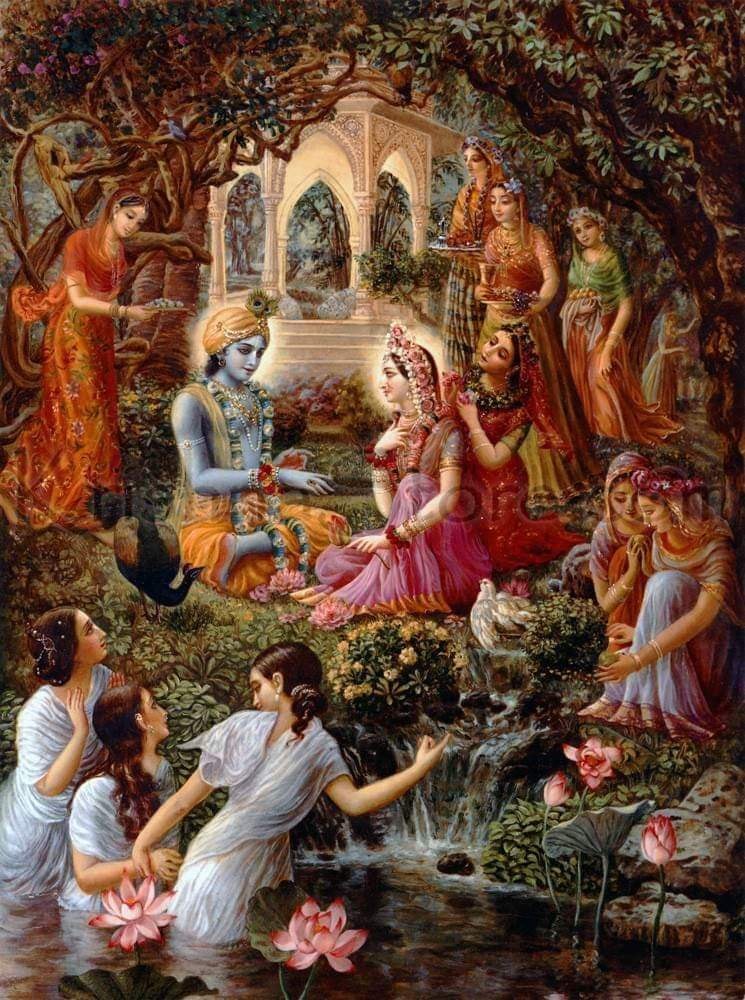
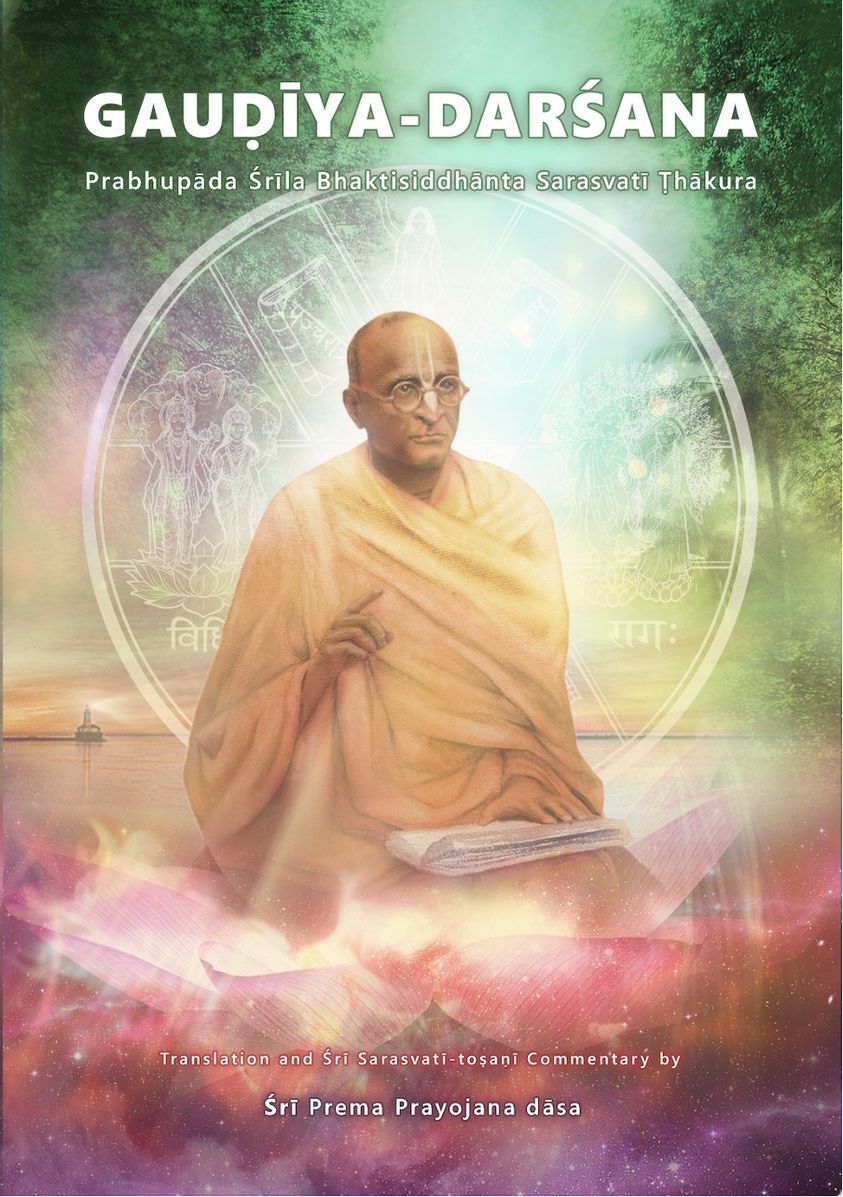

Thank you publishing this. This lecture is a masterpiece. Jaya Gurudeva!!!
Please accept this free Bhagavad Gita download
http://www.purebhakti.com/resources/ebooks-a-magazines-mainmenu-63/bhakti-books/english/32-bhagavad-gita/file.html